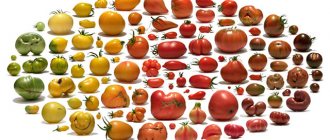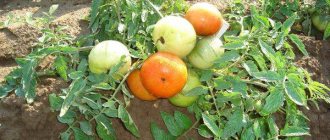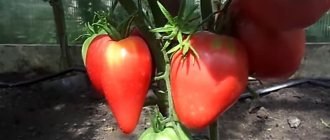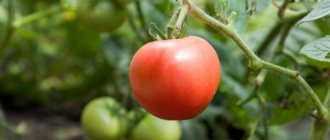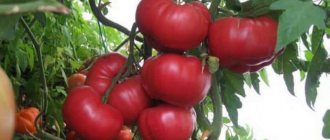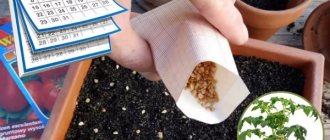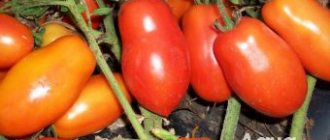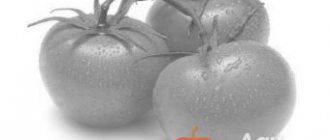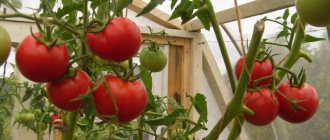Description and characteristics of tomato variety Fitous
A mid-early variety, the Fitous tomato, is intended for cultivation in greenhouses and open ground. It is popular with many summer residents for its positive qualities. Released in 1997.
What is the species
Tomatoes of this variety are quite popular. The description shows that they are unpretentious and resistant to diseases.
- Bush: determinate.
- Height: 50 cm.
- Stem: powerful.
- Inflorescence: simple.
- Number of tomatoes in a brush: from 4 to 6 pcs.
- Ripening time: 95-110 days (from seed germination).
- Color: red.
- Shape: oval.
- Weight: 50-70 g.
- Number of cameras: 2-3 pcs.
- Density: high.
- Peel: not hard, but does not allow cracking.
- Taste: excellent.
- Transportability: excellent.
- Shelf life: long time.
Planting and care
"Fitous" tomatoes grown by seedlings. They begin to sow seeds at the end of March or beginning of April (depending on the region). The seed planting depth is 1 cm.
Does not require pinching or gartering.
Planted in the ground at a distance of 50 cm between plants. Thus, no more than 3 bushes are placed per 1m2. The soil should be well moist and slightly acidic. You can add superphosphate (10 grams per hole).
It is best to water tomatoes after sunset, and the water should be warm. To obtain a high yield, you should feed the tomatoes. The first time, 2 weeks after landing in a permanent place. The second time before flowering, the third time before the active ripening of fruits.
Disease susceptibility
"Fitous", tomatoes that are late blight resistant. In addition, it is not susceptible to other common diseases.
In case of pest attack, it should be immediately treated with special preparations. But only if the plant does not bear fruit. During the period of fruit ripening, it is better to treat with folk remedies, this will prevent chemical elements from getting on the vegetables.
Harvest volume and application
The productivity of the Fitous variety is high. With proper agricultural technology and compliance with all necessary requirements, a small plant grows, strewn with vegetables.
Retains excellent taste regardless of the cooking method.
The application is very diverse, depending on who has the imagination. All favorite winter preparations are prepared with their participation. The taste of tomatoes is excellent; with whole-fruit canning, the appearance and integrity of the structure are preserved. Perfect for preparing salads and eating fresh.
Positive and negative aspects of the species
Many gardeners pay attention to the characteristics of good and bad in a plant. Making your final choice on this basis
- High yield.
- Disease resistance.
- Unpretentiousness and undemandingness.
- The fruits do not crack, last a long time and tolerate transportation well, maintaining their presentation.
- Does not require plant formation.
No disadvantages of the variety have been identified.
Opinions of summer residents regarding the Fitous tomato
Reviews from summer residents will help a novice gardener understand how to grow tomatoes, whether they should be fertilized or not, whether formation is necessary and much other useful information.
- Lyudmila Ponomoreva. They live in Siberia. He writes: “I grow it in open ground. Even the smallest tomatoes ripen. Excellent for preservation. Very good variety."
- Alexander. I planted “Fitous” on my plot. Several bushes produced a variety of other tomatoes. Definitely going to grow more.
- Margarita. He has been growing tomatoes on the plot for 3 years. Satisfied with the characteristics of the variety. The yield is very high, it formed into 2 trunks. The tomatoes turned out larger than in the description. After forming 6 brushes, the growth point was removed. I was satisfied with everything. The taste of pickled tomatoes is amazing.
Many summer residents choose this variety because it is resistant to late blight, is unpretentious and produces a lot of yield. Thanks to these qualities, it became a favorite for many of them.
Characteristics of the tomato variety Snowfall F1, its description
Every experienced vegetable grower has his favorites, which are found among representatives of each crop, and tomatoes are no exception. I also loved the Snowfall tomatoes. However, most summer residents secretly take part in a certain number of experiments every year aimed at finding new varieties of tomatoes.
Description of the variety
Tomato Snowfall F1 is a representative of late tomato varieties belonging to the first generation of hybrids. The bush of the plant is indeterminate, can be up to 2 meters high. Moderate spreading goes well with the abundance of green foliage, which requires close attention and mandatory formation.
READ MORE: Milagro herbicide instructions for use mechanism of action application rate
The leaves of the Snowfall tomato are simple and medium in size. The clusters in which the fruits ripen contain from 6 to 10 fruits. The excellent yield of tomatoes allows you to get up to 5 kilograms of selected fruits from each bush growing in a greenhouse. From planting the seeds to the appearance of the first ripe fruit, an average of 120 days pass. Harvesting can be done before snow appears.
Snowfall tomato fruits grow up to 80 - 120 grams. The tomatoes are flat-round in shape, with slight ribbing at the stalk.
When ripe, the fruits have a rich red color. The thin skin covering them protects them from cracking. The dense pulp contains a small number of seeds.
The taste of the Snowfall tomato is quite sweet, very rich and, as numerous reviews report, very pleasant. Sugars, which are contained in large quantities in tomatoes, make it easy to use Snowfall in baby food and in the preparation of a wide variety of dishes.
Snowfall fruits are flat-round, red and small. At the stage of full maturity they reach a weight of 60–80 grams. The taste is quite pleasant for a hybrid, moderately sweet.
Tomatoes of the Snowfall variety are perfect for pickling and pickling. Thanks to their small size, they can easily fit into any jar. When ripened on the bush, tomatoes can be eaten fresh, since their taste is suitable even for use in the diet of children.
Each fruit has 3 or 2 seed chambers, in which seeds are located in an average amount. In addition to salting, pickling and eating fresh, Snowfall fruits can be dried.
By adding Mediterranean spices to Snowfall tomatoes and drying them in the required manner, you can get excellent sun-dried tomatoes, the characteristics of which will not be inferior to expensive Italian tomatoes. Subsequently, such fruits can be used in cooking and as a spice.
The description on the packaging contains quite detailed information about Snowfall tomatoes, however, only vegetable growers who have been growing the variety for several years can name its obvious advantages. These benefits include:
- high productivity;
- excellent taste;
- unpretentiousness to growing conditions;
- spectacular appearance of ripe fruits;
- excellent keeping quality;
- the ability of tomatoes to tolerate transportation well;
- versatility of use;
- the possibility of growing both in a private farmstead and on an industrial scale;
- resistance to various viruses and diseases.
Of course, the list of advantages is very wide. However, the variety also has disadvantages:
- sensitivity to temperature fluctuations;
- frost intolerance;
- vulnerability to drought and sweltering heat;
- the need to form a bush;
- demands for tying;
- the need for constant removal of stepchildren;
- possibility of chopping tomatoes if there is excess foliage.
Summer residents also note another drawback: the inability to collect seeds for planting next year. Even ripened seeds are deprived of the advantages of the mother plant. This is sometimes offensive, but quite understandable: this factor is characteristic of all hybrid varieties. Despite this, the description and reviews of the Snowfall F1 tomato are the most positive.
Snowfall tomatoes are grown using the seedling method. Depending on the region of cultivation, you should choose the optimal time for planting seeds. In areas where the climate is cold, seeds should be planted in mid-to-late February. In the southern regions, this moment can be postponed until mid-March.
READ MORE: Tomato Winter cherry - description and characteristics of the variety
Before planting seeds in the ground, they can be treated with a solution of hydrogen peroxide or potassium permanganate. This is necessary to disinfect the material. Snowfall seeds have already undergone pre-sale preparation and do not require disinfection. Information about this can be found on each package of seeds.
The soil in which future plants will be planted should be light but nutritious. To obtain the above qualities, you can mix garden soil with humus and river sand. It is ideal if the vegetable grower has the opportunity to add superphosphate and wood ash to the soil.
After planting the seeds in common containers, you can later plant them in peat pots. This is very convenient, since there is no need to damage the root system of the plant during replanting into the ground later. Plants planted directly in peat pots do not need picking.
It is important that tomatoes are responsive to heat, fertilization and moderate moisture. Fertilizers applied to the soil must be systematized: first the plant needs nitrogen, then phosphorus and potassium. Organic fertilizer can also have a positive effect on crop growth.
Disease Control
Tomatoes Snowfall F1, like other hybrids, are resistant to major nightshade diseases. It is not afraid of mosaic, fusarium, or verticillium. The only thing a summer resident who decides to grow a Snowfall tomato on his plot should be wary of is late blight. You can protect the crop by spraying with preparations containing copper. Already affected parts of plants should be removed immediately.
Insect pests can be controlled. To do this, you can use industrial insecticides or use folk remedies. Decoctions of celandine and onion peels, tobacco dust and wood ash are excellent in controlling pests.
What gardeners say about “Dachnye Kora” tomatoes
Full information about the variety you are interested in can be obtained by reading the reviews of those who planted the plant on the site.
- Elena. I grew it for the first time. The experience was not very successful, but the landing conditions were to blame. Next year I will repeat the experiment, if I like it, I will plant more.
- Paul. One plant was planted to try and the characteristics intrigued me. I was pleased with the result. Formed into one stem. I tied up both the plant and the brushes.
- Alexandra. I planted it on the advice of the store salesperson. I didn’t regret it, as the whole family was delighted with the taste of fresh fruits.
“Dacha bins” are suitable for lovers of fresh fruits and juice. And their harvests will delight any gardener.
How to get a harvest?
The barrel is an unpretentious hybrid. But it is possible to achieve the desired indicators if you follow the advice of agronomists. You should follow simple recommendations:
- purchase seeds only from trusted producers;
- monitor the expiration date (after it expires, germination rate decreases);
- store the pre-purchased bag at the specified temperature and humidity;
- pre-planting preparation of hybrid seeds is not required;
- Tomato Barrel should be sown in the second ten days of March;
- disinfect trays and equipment (potassium permanganate, alcohol, vodka, soda ash solution are suitable);
- when planting in cassettes, plant 2 seeds in each;
- when placing in trays, sow in rows with a distance of 2.5 cm;
- seeds should be planted 1–1.5 cm;
- Maintain a temperature of 23–25 degrees Celsius until germination;
- monitor soil moisture;
- reduce the temperature after pipping to 18 degrees Celsius;
- dive tomatoes planted in trays into separate cups after two true leaves appear;
- fertilize the planting site in advance (add a mineral complex (nitrogen: potassium: phosphorus) according to the manufacturer’s instructions);
- planting pattern: 40×70 cm;
- place on permanent beds after returning spring frosts;
- to strengthen the plants, add double superphosphate when planting (1 tablespoon per bush);
- for the first three days, shade the plantings from the sun with white non-woven material;
- bushes require garter: the plant overloads itself with fruits;
- to speed up ripening, it is recommended to lighten and root the plants once a week;
- to preserve moisture, it is recommended to mulch the soil with rotted organic matter and dark non-woven material;
- the hybrid requires moderate watering: after complete drying.
Dry watering - loosening - should not be neglected. The procedure improves gas exchange and retains moisture.
Gardeners should take into account: a hybrid planted in a greenhouse will grow taller and have more foliage.
Advantages and disadvantages of the variety
Having studied the positive and negative aspects, the garden owner will be able to decide whether to use this variety for growing on his plot or not. Experienced gardeners highlight the following advantages of dacha tomatoes:
- High yield.
- The plant is unpretentious in care.
- The fruits do not crack, are stored for a long time and have good transport characteristics.
- Tomatoes taste great.
- Used to prepare many varieties of preparations for the winter.
The disadvantages of the variety include the following:
- bushes need to be formed;
- Mandatory treatment for diseases is required.
Tomato Country bins characteristics and description of the variety yield with photo
Collation of varieties
Thanks to a detailed description of the variety of vegetable crop, the owner of the plot will be able to decide whether it is suitable for planting in his garden, learn about the rules for its cultivation, if followed, you can reap a rich harvest.
- class indeterminate;
- bushes grow up to two meters high;
- Each cluster produces approximately six fruits;
- The ripening period ranges from 105 to 115 days from sowing the seeds.
- Harvest summary:
- grown tomatoes have a shape reminiscent of a plum;
- the burden of each fruit is from 200 to 450 grams;
- red iridescence;
- the skin is thin;
- Tomatoes of this variety are well transported and stored for one month.
Description of plum-shaped large tomatoes Country bins and features of growing the variety
Many gardeners are interested in how to grow tomatoes. Country bins. Often, finding the right variety takes a huge amount of time. After all, every summer resident wants to get a rich harvest of tasty fruits. Country bin tomatoes meet all these requirements; the description and characteristics of the variety will make it possible to understand whether this species is worth growing in your garden plot, and reviews from those farmers who planted this variety will finally strengthen the choice.
The tomato "Dachnye bins" is indeterminate, that is, practically unlimited in growth. The maximum height is 2 m. Each cluster can bear about 5-6 ripe fruits, and on average about 110 days pass from the appearance of the first shoots to the harvest of the initial harvest.
Plum-shaped large fruits have an excellent sweetish taste. These tomatoes are also suitable for sale, since the thin but very dense peel does not allow the tomatoes to crack and makes it possible to transport vegetables over long distances without loss.
This variety can be stored in a dark and cool place for about a month without losing its properties. The fruits have a rich red color, and the maximum weight of a tomato, especially during the first harvest, can reach 450 g.
Plants are grown in a greenhouse. Planting in open areas or under a film covering is allowed. Farmers plant this plant in seedlings. The seeds are planted in separate containers about a couple of months before the planned transfer of the plant to a permanent place.
In order to increase productivity and strengthen bushes, summer residents are recommended to carry out agrotechnical measures, including:
- Dive. With it, the emerging seedlings must be planted in several separate containers. This greatly reduces the stress that tomatoes experience when transplanting to another location.
- Hardening. Seedlings must be exposed to sunlight and open air for 10 days before planting. The first time it should stand in the open air for about 20 minutes, gradually this time needs to be increased. The last time the seedlings can be taken outside is about 8 hours.
- Seedlings must be fed with special preparations that stimulate their growth. It is necessary to observe the regime of heat and light.
It is necessary to plant tomatoes in open ground, taking into account the weather conditions established in a particular region. No more than 6 bushes can be planted per 1 m² of area. When planting a tomato, you must immediately install a structure to which the bushes will be tied. This is necessary, because the fruits are quite heavy and can simply break the bush.
Be sure to carry out the formation of a bush. As a rule, experienced gardeners recommend forming the plant into one stem, eliminating the stepsons. If such requirements are met, the bushes of the variety can bring the farmer up to 9 kg of fruit.
You need to water in the evening using warm, settled water. To prevent a number of diseases, it is recommended to constantly weed the plant, loosen and hill up the soil underneath it.
The use of tomatoes in cooking is quite widespread, however, for example, such tomatoes are not suitable for whole-fruit canning due to their large size. But you can prepare them in the form of pieces in their own juice.
The fruits can be used in the production of various sauces and tomato juice. Suitable for fresh consumption or as a salad component.
Gardeners who grow this variety characterize it positively. So, for example, a summer resident who planted this tomato in a greenhouse notes that of all the varieties that she grew in greenhouses, the Country Bins tomatoes have the best taste, almost the same as that of fruits grown in open ground. The yield of this tomato is excellent.
Fans of vegetable plantings sometimes have to spend quite a lot of time searching for the optimal type, the qualities of which will fully meet the requirements of its household members. Country bins are large-sized tomatoes, the variety's yield is very high.
Thanks to a detailed description of the variety of vegetable crop, the owner of the plot will be able to decide whether it is suitable for planting in his garden, learn about the rules for growing it, if followed, you can reap a rich harvest.
Breeders describe the Dachnye Zakry variety as follows:
- indeterminate variety;
- bushes grow up to two meters high;
- approximately six fruits are formed on each cluster;
- The ripening period ranges from 105 to 115 days from sowing the seeds.
- Harvest Description:
- grown tomatoes have a shape reminiscent of a plum;
- the weight of each fruit is from 200 to 450 grams;
- color red;
- the skin is thin;
- Tomatoes of this variety are well transported and stored for one month.
Planting of tomatoes of the Dachnye Zakry variety is carried out in beds, in greenhouses and under film. This vegetable crop is grown from seedlings. Sowing of planting material should be carried out 60 days before the grown seeds are transferred to a permanent place.
The plant will be stronger if you follow some rules. Recommendations for planting are as follows:
- Dive. To reduce stress during transplantation, seedlings should be pre-placed in separate containers.
- Seedlings need to be hardened off. To do this, it should be exposed to the sun for ten days. Initially for a third of an hour, gradually increasing the time spent on the street up to eight hours.
- It is necessary to observe the light and heat conditions, as well as feed the seedlings with special means that stimulate their growth.
- Tomato bushes should be planted in beds, taking into account the climate of the region. 5-6 bushes are planted on one square meter of soil. When planting, the plant must be tied up, since the trusses may break under the weight of the tomatoes.
- It is also necessary to form a bush. To get a good and high-quality harvest, you should carry out pinching, that is, remove all excess shoots, leaving only one stem.
- The plant should be watered in the evening using warm water. For preventive purposes, in order to prevent the development of the disease, vegetable beds must be weeded, loosened and hilled.
This variety is distinguished by large fruits; up to six tomatoes are formed in each cluster. Eight clusters are formed on one bush. For this reason, the yield of Dachnye Zakry tomatoes is quite high. From each bush, the owner of the garden will be able to collect up to 9 kilograms of fruit. This is possible if you follow the above growing recommendations.
Tomatoes of this variety are widely used for culinary purposes. Tomato pastes, sauces, ketchups, and drinks are prepared from tasty and aromatic tomatoes. In addition, they are used to prepare preparations for the winter.
Having studied the positive and negative aspects, the garden owner will be able to decide whether to use this variety for growing on his plot or not. Experienced gardeners highlight the following advantages of dacha tomatoes:
- High yield.
- The plant is unpretentious in care.
- The fruits do not crack, are stored for a long time and have good transport characteristics.
- Tomatoes taste great.
- Used to prepare many varieties of preparations for the winter.
Growing and care
Tomato variety Kolobok is recommended to be grown in open ground in the Central region of the Russian Federation:
- It is recommended to sow seeds for seedlings at the end of March.
- The seed sowing depth is 1–1.5 cm.
- In the phase of appearance of the first true leaves, plants are picked.
- After picking and before planting seedlings in the ground, 2-3 fertilizing with mineral fertilizers should be done.
- 7–10 days before transplantation, the sprouts must undergo a hardening course. To do this, you need to place the seedlings on the balcony or open the window, avoiding drafts.
- Moving to permanent residence is carried out from April to May, depending on climatic conditions.
- Planting pattern - 50x60 cm.
- The bushes do not require shaping, but as they grow and produce fruit, they may need to be tied to a support.
- Kolobok, like all tomatoes, needs timely watering and periodic hilling. It is advisable to water moderately and at the root. Since excess moisture can lead to late blight and other fungal diseases.
- To avoid collisions with insect pests, it is recommended to carry out preventive spraying of plants.
Reviews from those who have already planted the Kolobok variety are mostly positive and speak about the unpretentiousness of the tomato, and also highlight its excellent taste and attractiveness of the fruit.
Planting and care
Tomatoes of this variety are planted in a greenhouse, open ground and under covering materials. They use the seedling growing method. Seeds are sown 2 months before transferring to a permanent place.
In order for the seedlings to be stronger, it is recommended to carry out the following activities:
- Dive. By planting in separate containers, you can reduce the stress level during transplantation.
- Hardening. Why is it exposed to sunlight for 10 days? First for 20 minutes, gradually increasing the time spent in the open air to 7-8 hours.
- Feeding with growth-stimulating drugs, compliance with heat and light conditions.
Planting in open ground is carried out taking into account regional weather conditions. 4-6 bushes are placed per 1 m2. When you plant a plant, you definitely need to tie it up, as heavy fruits can break off the trusses.
The bush requires mandatory formation. The best result is achieved when all stepsons are removed. Leave one stem.
Watering is carried out in the evening, warm water is used. Weeding, loosening, and hilling are carried out to prevent diseases.
Why should you plant?
Large-fruited tomatoes are loved by gardeners. One berry is enough for salad or vegetable cutting. The insufficient yield is disappointing: the bush is pleased with 4–5 tomatoes.
https://youtube.com/watch?v=O3D1P75Z6ig
But the Keg is another matter. With proper agricultural technology, it is possible to get 2–3 times more fruit. This property of the hybrid attracts gardeners.
Characteristics and description of the Orange Barrel:
- the tomato has an average ripening period (from 111 days after germination);
- designed for open ground, unheated greenhouses and open ground;
- indeterminate hybrid;
- juicy green tops;
- prone to fouling by stepsons;
- the plate size is small;
- each stem has 4–5 racemes;
- There are up to 6 fruits in a brush.
The bushes grow powerful. The plant overloads itself with fruits. Requires gartering and pinching.
Gardeners are pleased with the heat and drought resistance of the hybrid. The barrel sets fruit and ripens at borderline temperatures. Gardeners do not need to come to water and ventilate the plantings. It is enough to hold events once a week.
Brief description of the Sweet Donut tomato and growing features
The Sweet Donut tomato is very popular among lovers of sweet and yellow nightshade varieties. It has a number of positive qualities: the plant is resistant to many diseases, easy to care for, and produces a high yield.
The fruits of the Sweet Donut variety have an original taste. Tomatoes are practically devoid of acid, the pulp is juicy and sugary. Housewives love this tomato for its taste. This is a salad variety, it is suitable for making sauces and lecho.
The variety was bred by Siberian breeders. The tomato is suitable for growing in greenhouse conditions and in open ground. The unpretentiousness of the Sweet Donut tomato makes it a favorite in the garden among representatives of yellow-fruited varieties.
Before you start growing this variety, you should familiarize yourself with its characteristics and recommendations given by the manufacturer regarding care.
General characteristics of the variety
Tomato Sweet Donut has the following characteristics:
- The bush belongs to the genus determinant, reaches a height of about 1 m. The trunk is strong, not spreading, the plant needs to be tied to a support. Experts recommend forming a bush into 1 trunk.
- It is mandatory to carry out stepsoning.
- The foliage is of regular shape and dark green in color.
- The formation of inflorescences begins after 1-2 leaves.
- The tomato has an ordinary brush; it bears no more than 8 fruits.
- The plant is an early ripening variety; the first harvest can be harvested 90-95 days after sowing.
- The Sweet Donut variety has good resistance to many diseases.
- Has high productivity. During a season, more than 5-6 kg can be collected from 1 m².
The description of the fruits indicates their friendly and early ripening. Tomatoes have a round shape and are bright in color in amber-yellow shades.
The tomato skin is thick and smooth. The fruits are not prone to cracking and are excellent for long-distance transportation.
On average, the weight of 1 tomato reaches 100-150 g, and under excellent growing conditions you can achieve results of 200 g.
Seeds are usually planted in the first half of March, but this procedure can be extended until April.
Before planting, the seeds must be properly processed. To disinfect planting material, it is customary to use a weak solution of manganese, and to stimulate growth, a special activator is used. The seeds are kept in the solutions for no more than 30 minutes, after which they are washed in clean water and carefully laid out on a cloth or paper sheet to dry completely.
To grow seedlings, special containers are used, which are filled with a pre-prepared earthen mixture. You can prepare fertile soil yourself; to do this, you need to mix equal parts of soil, sand and peat. The soil must be well moistened before planting.
The seed is immersed in the ground to a depth of 2-3 cm, after which the box with seedlings is covered with film and transferred to a room with good lighting. The air temperature for keeping seedlings should not be lower than +16-17 °C.
Every day it is necessary to ventilate the mini-greenhouse and monitor the condition of the soil. Excess moisture and dampness can have a detrimental effect on young shoots.
Seedlings are planted in open ground or a greenhouse 2-3 months after sowing the seeds. During this time, the root system of plants grows well and strengthens.
The beds for planting tomatoes need to be prepared in advance; many gardeners add special fertilizers to the soil in the fall. In the spring, immediately before planting, a solution of vitriol is added to the soil, and later humus and wood ash or other complex mineral fertilizers are added to the soil.
No more than 4 plants are planted per 1 m². The distance between bushes should be at least 40-50 cm, and between rows - 60 cm.
Reviews about the Sweet Donut tomato are only positive; it has excellent characteristics and fully meets them.
Secrets of growing tomato Argonaut F1 - planting rules and care
Tomatoes are tasty and healthy vegetables that are easy to care for, which is why they are so popular. There are many varieties and hybrids that differ in color, taste, size and yield.
| Height | Landing location | Ripening time | Fruit color | Fruit size | Origin | Fruit shape |
| short | Greenhouse, Open ground | Early ripening | Reds | Large | Hybrid | Round |
The fruits are smooth, without cracks or dents, have a rich taste with a subtle sourness.
Country of origin and year of registration
The hybrid was bred in 2011, but was included in the register only in 2015. This variety was created by breeders from Russia. And in such a short period, he managed to take his place in the garden beds and in the hearts of many summer residents.
Advantages and disadvantages
- High yield
- Early fruiting
- Resistance to many diseases
- Excellent taste
- Neat, marketable fruits
- Do not deteriorate during long-term storage and transportation
- Resistance to temperature changes
Minuses:
- Tendency to overwhelm
- The need for tying
Productivity
The plant can be grown both in open ground and in a greenhouse. Under a canopy, the fruit yield is slightly higher and amounts to 4.5 kilograms per bush. In open ground, in the fresh air, the yield ranges from 3 to 4 kilograms.
Features of cultivation
We sow the seeds in early April. Then, by the end of May, you can transplant the seedlings into indoor or open ground. Although there are no strict instructions for planting, planting under sheds or in greenhouses is recommended for northern regions. In the southern regions, you can choose any type of landing.
We form a bush with 3 stems. Don’t forget to tie our plants to stakes, because as we remember, they are prone to “overwhelming”. Stepchildren usually do not appear in this variety, but if they appear, do not forget to remove them. If the stepsons are left, the plant will begin to branch heavily, thicken and become oversaturated with tomatoes. The tomatoes will grow small.
When they are small, they absorb only a small part of the nutrients. If you are late with pinching, you can cause significant damage to the plant, which will significantly reduce the yield.
It is recommended to fertilize with organic matter, a maximum of 4 times per season.
Landing
We plant the seeds in pots in early April. We check the seeds for germination. We place them in salt water, throw away the ones that drown, and wash the ones that remain afloat under warm, running water, dry them and sow them.
Do not forget that the pots must have holes that provide the plants with the necessary oxygen. We plant the seeds to a depth of one centimeter. Water it periodically and place it in the sun.
We transplant into the ground after the end of frost around the end of May. Select an area that receives moderate sunlight and is protected from strong winds. Before planting, loosen the soil, you can add organic fertilizers.
Due to the fact that the variety is considered low-growing, planting is recommended according to a 60 by 60 centimeter pattern.
After the plants have been planted, regular care should be established. The variety is very unpretentious, so it will not cause problems in cultivation. It is necessary to periodically loosen the soil and do not forget to water it when it dries out.
Properly formed bushes are the key to success. Remove all the stepsons from the bottom to the very top, but leave the two upper trunks. Tomatoes form into three stems. The leaves covering the brushes must be cut off.
Pest and disease control
This hybrid is not prone to disease, but for preventive purposes, treat it with Fitosporin.
The mole cricket poses the greatest threat to tomatoes among pests. With powerful claws, it digs a hole up to 1 meter deep, but likes to settle closer to the surface and the sun. You can fight it in several ways.
- Installation of fences. We fence the area on all sides with tin plates going 55 centimeters deep.
- Treating holes with kerosene. Mix 0.1 liter of kerosene and 10 liters of water, pour one and a half spoons into the holes. The procedure is carried out in the evening.
- Pine smell. Dig small holes around and throughout the garden and bury pine needles in them; you can also put them in holes.
- Fish heads. Bury fish heads to a depth of no more than 30 centimeters, and the mole cricket will not bother you.
In addition to traditional methods, you can resort to special repellers. They are: chemical, electrical and ultrasonic. Choose those that are more convenient for you to use.
The best varieties of tomatoes with descriptions
Before you accurately choose a variety or hybrid of tomatoes, you need to decide where exactly they will grow.
For open ground, low-growing varieties that will ripen early are more suitable. Mid-ripening species in good summer weather can produce a fairly good harvest, but they are susceptible to microflora, which can destroy most fruits.
It is customary to grow tall varieties and various hybrids in greenhouses. Here you can plant absolutely any tomatoes, even late-ripening ones.
Description of the tomato variety Ryabchik, its characteristics and cultivation
Fans of high-yielding low-growing tomatoes should definitely pay attention to the Ryabchik tomato when selecting a collection of seeds. The peculiarity of the variety is that large fruits are formed on a low bush.
Are there any other benefits to this variety?
Description
Ryabchik is a mid-season determinate variety of tomatoes. The plant is not prone to strong pinching, which eliminates the need for gardeners to pintle.
Characteristics of the large-fruited variety:
- From the emergence of seedlings to the beginning of fruiting, 110–115 days pass.
- The height of the bush varies from 60 to 75 cm.
- The tomatoes are flattened on top and bottom. The surface of the red fruit is divided into even slices by thin yellow stripes. Due to its color and shape, the vegetable looks like an apple. Fruit weight – 200–300 g.
The yield of the crop is high: under normal weather conditions and appropriate care, 5–6 fruits are set on the branch. Tomatoes ripen quickly almost simultaneously. Thanks to active pouring, the fruits simply do not have time to become infected with late blight. Also, unlike many large-fruited varieties, tomatoes are resistant to cracking.
The variety is suitable for cultivation in open and closed ground. The fruits are used for fresh consumption and for preparing tomato juice.
Features of cultivation
Caring for Ryabchik tomatoes is no different from caring for all subspecies of vegetables. In order for the plant to develop normally and ultimately produce a good harvest, a number of manipulations need to be carried out:
- Sowing. Seeds are sown in a loose pre-calcined and cooled substrate 50–55 (maximum 60) days before transplanting the seedlings into the ground. It is imperative to observe the sowing time, otherwise growing seedlings will be useless if the plants have greatly outgrown by the planting date. In order to speed up the appearance of sprouts on the surface, the container is covered with film or glass. To avoid soil mold and damage to planting material, the shelter is periodically removed. As soon as the young plants are a week old, the temperature in the room is set at +15–+18 C. At the age of 2 weeks, the temperature is raised to +22 C.
- Picking. If seed germination is 100% and the interval between sprouts is less than acceptable, plants that have formed 2–3 leaves are transplanted into separate cups or pulled out. Seedlings of the tomato variety Ryabchik are planted in a permanent place after the formation of 5–6 leaves. Experienced gardeners recommend double transplanting, because manipulation promotes the formation of many lateral roots. As you know, the more powerful the root system, the better the condition and fertility of the plant.
- Watering. The vegetable crop is not very demanding on humidity, however, the plants need to be watered regularly. The soil should not be allowed to dry out too much, otherwise the description given by the manufacturer will bear little resemblance to reality. After each watering or heavy rain, the soil in the tomato bed is carefully loosened with a hoe.
- Feeding. Tomatoes of this variety are fertilized with a solution of chicken droppings and manure, and compost. During the growing season, the bushes are pampered with fertilizers 3-4 times.
Harvest volume and application
“Dacha bins” - large-fruited tomatoes, in one cluster there are 5-6 fruits, on one plant there are 8 clusters. Therefore, 1 bush can produce 9 kg of fruit. The yield is high if basic agrotechnical requirements are met.
But housewives who grow them on plots prepare them for the winter in pieces in their own juice. The variety is also used for preparing tomato juice, paste, ketchup, and sauces. When fresh, the fruit has excellent taste.
Collation of varieties
Content
Description
The best varieties of tomatoes | Volzhsky Gardeners' Union
Hello dear gardeners, in today’s publication we will focus on some hybrid varieties of tomatoes.
The review presents varieties of tomatoes bred, which has been operating in this market since 1993 and has established itself as a reliable supplier and responsible producer of agricultural seeds.
After all, it’s no secret that productivity depends not only on the quality of the seeds, but also on the quality of the seedlings. How to grow seedlings is written in this article. So, let's move on to the review itself:
Tomatoes “Babushkino Lukoshko”
Variety "Granny's Basket"
Tomatoes “Babushkino Lukoshko” are a medium-early, tall-growing tomato for film greenhouses. The "grandmother's basket" tomato is large-fruited, its fruits are bright red, with three to four chambers inside, fleshy, juicy and very sweet. Tomato "grandmother's basket" is a guarantee of high yields.
Bananza tomatoes
Variety "Bananza"
The fruits of the tall Bananza variety are unique in their banana-shaped shape. The fruits reach a length of 15 centimeters and a diameter of 4-5 centimeters, and due to their shape they are very convenient to preserve. Bananza tomato can be grown in film greenhouses.
Tomatoes "Country bins"
Variety “Country bins”
The “Dachny Bed” tomato is a real gift for every summer resident. The garden tomato fruits are large, fleshy, juicy, sweet and perfect for both canning and salads; large fruits reach a weight of 250 - 300 grams.
Tomatoes "Lubimets"
Variety "Lubimets"
The variety "Lyubimets" is an early ripening variety. This variety is recommended to be grown in film greenhouses, under temporary film shelters, and in open ground. The “Lubimets” variety is very productive. One inflorescence produces up to 8 fruits with an average weight of 150 - 200 grams. The tomato is very fleshy, very sweet and very tasty, which makes it possible to use it for salads.
Tomatoes "Nakhimov"
Tomato variety "Nakhimov"
The “Nakhimov” variety is an early ripening tomato; it is an ideal option for lovers of open ground tomatoes and canning. The strong skin prevents the fruit from cracking during canning.
The pulp is sweet with a high sugar content, which gives the canned food an excellent taste.
A worthy continuation of this series are the “Golitsyn” and “Ushakov” tomatoes - these are ultra early, early ripening varieties for open ground.
Tomato "Ushakov"
The “Ushakov” tomato belongs to the early-ripening varieties of open ground canning type, just like the “Nakhimov” tomato. Its unusually high load is combined with the early ripening and strength of the fruit. The fruits of this variety have a high sugar content and are excellent for both canning and fresh consumption.
Tomatoes "Pervoklaska"
Tomato variety "Pervoklaska"
Ultra-early variety “Pervoklaska” Ripens in literally 90-95 days in open ground.
Its advantage is that its fruits contain a large amount of antioxidants and for those who love not only delicious tomatoes, but also care about their health, this is an excellent option. The “Pervoklaska” tomato can be grown both under temporary film shelters and in open ground.
Tomatoes “Sugar Nastasya”
Tomato variety “Sugar Nastasya”
The “Sugar Nastasya” tomato fully lives up to its name; its fruits are truly sugary. This is a worthy continuation of the beloved “Bull’s Heart” tomato. This is an improved tomato of the “Bull’s Heart” variety. It is characterized by extraordinary productivity and excellent taste.
Tomatoes "Orange giant"
Tomato variety "Orange Giant"
The medium-sized tomato “Orange Giant” is not only productive, not only early ripening, but also extremely healthy. Its fruits contain a large amount of carotene, which is actually confirmed by the orange color of its fruits.
This variety is suitable for growing in greenhouses and temporary light-transmitting shelters. I hope our review helped you with choosing tomato seeds. Of course, you shouldn’t buy seeds from random sellers; I think it’s unnecessary to explain the reason, because everyone has been burned more than once.
You buy one thing, and another sprouts, and it’s good if it sprouts at all! Therefore, you need to choose only a trusted seller, for example: this one.
By clicking on this link you can read other articles that will be useful to gardeners. We wish all our readers good health and excellent harvests.
About how to protect tomatoes from late blight.
Tomato Legend Tarasenko
photo by Valentina Redko
Mid-season, indeterminate, high-yielding, reliable tomato variety. Recommended for growing in greenhouses.
The second name of the variety is Nadiya, this is the last variety created by Feodosia Makarovich Tarasenko.
A bush up to 2 meters high, requiring tying to a support and pinching. The best result was obtained when forming a plant with 1 or 2 stems.
The brushes of this variety are complex, with 10-20 ovaries in each.
Basic qualities of fruits
photo by Valentina Redko
The fruits are elongated cream with a drawn-out spout, smooth, glossy, red in color at maturity, weighing 80-100 grams, excellent taste. These tomatoes are great for pickling and canning, and they are also tasty in fresh salads.
Advantages of the variety: high yield, excellent commercial quality of the fruit.
Productivity of the Legend Tarasenko tomato: up to 5 kg of fruit from 1 plant (subject to agricultural practices, watering and fertilizing).
Features of cultivation, planting and care
We recommend sowing the seeds of this tomato for seedlings 60-65 days before the intended planting in the ground. Seedlings dive at the stage of two true leaves. When planting seedlings in a permanent place per 1 sq. It is recommended to place up to 3 plants per meter of land; when forming into 1 stem - up to 4.
Further care for tomatoes consists of timely watering, fertilizing with complex mineral fertilizer, pinching and preventive measures to protect against diseases and pests.
Video: how to shape a tomato
If you grew Legend Tarasenko tomatoes, please write whether you liked them or not. What was the yield and taste of the fruit under your conditions? Will you grow them again? Briefly describe the advantages and disadvantages (pros and cons) of this tomato in your opinion. If possible, attach to your review a photo of the entire bush as a whole or individual fruits you grew. Thank you!
Your reviews of the Legend Tarasenko tomato and additions to the description will help many gardeners evaluate this variety and decide whether it is worth planting or not.
Advantages of the Spring F1 tomato and rules for growing a hybrid variety
Siberian breeders have once again pleased consumers with a new hybrid of nightshade crop. This is a Spring F1 tomato. It is easy to maintain and highly adaptable to soil and weather conditions.
The Spring tomato variety is grown in greenhouses, hotbeds and open ground. In almost all regions it takes root well and produces a good harvest. Any vegetable grower first of all strives to grow a plant not only with large fruits, but also with excellent taste. This is exactly what the Vesna variety is. The tomatoes have a pronounced taste, with a small amount of acid, the flesh is sugary and juicy.
Reviews received from gardeners with experience in growing the Vesna variety are only positive.
The main advantages of the variety
The bush has a small growth, reaching a maximum of 50-60 cm in height. The growing season is about 90-100 days. The plant has a strong trunk and a powerful root system, which goes 1.5-2 m deep into the ground, thanks to which it helps the tomato not shed foliage and fruits during periods of natural vagaries.
The inflorescence of Spring tomatoes is ordinary. The first brush is formed after 6-7 leaves. Fruits are set in 5-7 pieces. for 1 brush. The bush needs a garter and additional support, especially during the ripening period of fruits that gain weight.
The leaves are slightly elongated and have a pronounced corrugated pattern, dark green in color, and do not fill the bush very densely. The productivity of the Spring tomato is high and stable. From 1 bush over the summer you can remove up to 5 kg of fruit.
Description of the Spring tomato fruit:
Tomatoes have a beautiful, even red color. Their peel is dense and smooth, firmly protecting the pulp from sunlight and cracking. Tomatoes weigh from 150 to 200 g. The shape of the fruit is round with slight ribbing. The pulp has 4 chambers filled with small seeds. The taste of the fruit is not bland, rich with a subtle spicy aftertaste. Vesna variety tomatoes are perfect for preparing tomato products and eating fresh. The harvest is stored for a long time. The tomato is suitable for transportation over long distances without losing its presentation. Tomatoes can be picked from the bush at the ripening stage
It is important that the fruits acquire a light milky color. Then they ripen well in a warm room.
The peculiarities of the variety are its strong immunity to tobacco mosaic and late blight. Vesna tomatoes are not demanding to care for. To grow these tomatoes, it is enough to know the basic rules of agricultural technology. If all these requirements are met correctly, the plant will reward you with rich and high-quality harvests until the fall.
Growing rules
Typically, the characteristics and description of the variety are placed by the manufacturer on the seed package. It also shows a schedule for planting seeds for seedlings and planting them in open ground.
Sowing tomato seeds Spring for seedlings is carried out in the spring. The optimal time for planting is considered to be the second half of March. Before planting, seeds must be treated in a manganese solution. Its concentration should be weak. The material is immersed in liquid for 30 minutes, after which it is allowed to dry thoroughly. To activate growth, you can use special stimulants.
Soil for seedlings is prepared from the following components:
- coarse river sand;
- turf land;
- peat.
All components are mixed and moistened. A shallow container is suitable for growing seedlings. The soil in it is lightly compacted and holes are made 1.5-2 cm deep. They are covered with soil on top, but not compacted.
It is important to water immediately and cover the container with film. Seedlings are kept in a room where the temperature is not lower than +22…+25°C
The film is removed with the appearance of the first shoots. Water the seedlings with warm and settled water from a spray bottle. It is important not to over-moisten the soil and not cause moisture stagnation.
When 2 leaves appear on the sprouts, a dive is performed. You can plant seedlings directly in peat pots.
Before planting, seedlings can be hardened off. To do this, in the morning and evening, it is taken outside for 1 hour. This process begins 15 days before planting.
The seedlings are ready for planting when they have 6-7 leaves and 1 inflorescence. The beds need to be fertilized before planting. Some gardeners use complex mineral fertilizers for this, while others prefer ordinary humus.
Bushes are planted at the rate of 3-4 plants per 1 m². The holes should be immediately mulched with small sawdust or straw. At first, it is necessary to water the beds only with settled water. After 1 week, the seedlings need to be fed with mineral fertilizer. During the growing process, you should perform pinching and form a bush of 1-2 stems.
Description of plum-shaped large tomatoes Country bins and features of growing the variety
Many gardeners are interested in how to grow tomatoes. Country bins. Often, finding the right variety takes a huge amount of time. After all, every summer resident wants to get a rich harvest of tasty fruits. Country bin tomatoes meet all these requirements; the description and characteristics of the variety will make it possible to understand whether this species is worth growing in your garden plot, and reviews from those farmers who planted this variety will finally strengthen the choice.
The tomato "Dachnye bins" is indeterminate, that is, practically unlimited in growth. The maximum height is 2 m. Each cluster can bear about 5-6 ripe fruits, and on average about 110 days pass from the appearance of the first shoots to the harvest of the initial harvest.
Plum-shaped large fruits have an excellent sweetish taste. These tomatoes are also suitable for sale, since the thin but very dense peel does not allow the tomatoes to crack and makes it possible to transport vegetables over long distances without loss.
This variety can be stored in a dark and cool place for about a month without losing its properties. The fruits have a rich red color, and the maximum weight of a tomato, especially during the first harvest, can reach 450 g.
Plants are grown in a greenhouse. Planting in open areas or under a film covering is allowed. Farmers plant this plant in seedlings. The seeds are planted in separate containers about a couple of months before the planned transfer of the plant to a permanent place.
In order to increase productivity and strengthen bushes, summer residents are recommended to carry out agrotechnical measures, including:
- Dive. With it, the emerging seedlings must be planted in several separate containers. This greatly reduces the stress that tomatoes experience when transplanting to another location.
- Hardening. Seedlings must be exposed to sunlight and open air for 10 days before planting. The first time it should stand in the open air for about 20 minutes, gradually this time needs to be increased. The last time the seedlings can be taken outside is about 8 hours.
- Seedlings must be fed with special preparations that stimulate their growth. It is necessary to observe the regime of heat and light.
Description – brief description
The variety is recommended by breeders for growing in greenhouses, under covering materials. In warm climate zones it is successfully planted in unprotected soil. A tall crop should be formed into 1 stem, removing the stepsons in time, which allows you to achieve an excellent harvest of large-fruited tomatoes. Main characteristics of tomatoes:
- indeterminate variety, the height of powerful bushes reaches 2 m;
- each cluster produces 5-6 fruits;
- ripening period – from 105 to 115 days;
- large plum-shaped multi-chambered fruits;
- The pulp is fleshy, sweetish with a rich aroma.
According to ripening time | By type of growth | By type of use | By growing method | Fruit weight in (g) | Yield (kg/m²) |
Basic ideas about the variety
The description of the variety will give the summer resident the opportunity to understand whether it is suitable for growing on the site and how to grow it correctly to get a good harvest.
Plant:
- Indeterminate.
- 2 m high.
- 5-6 tomatoes in a brush.
- Ripening within 105-115 days.
Fruit:
- Shape: plum-shaped.
- Weight: 200-450 gr.
- Color: red.
- Skin: thin.
- Transportability: good.
- Shelf life: month.
